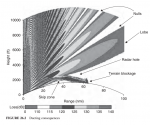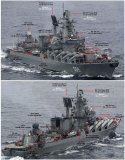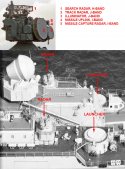Let's take the example of Mineral-ME , which gave rise to the Ukrainian Mineral-U. This radar is commonly used on Russian ships and is said to have an OTH capability of up to 250 km in active auto-refraction mode.This is why Surface scan radars are mostly in X or C band. as those bands have propagation advantages. It may still lost low altitude contact but can quickly regain it. Something of lower frequencies like S or L doesn't have. They're more suited for high-medium altitude area defense.
The reality is that a ship with this radar would not even need air assets to find OTH targets. I still don't quite understand how this works.
I don't understand how this is possible and until today I haven't found anyone to explain to me how an X-band (I-band) radar has OTH capability, which is characteristic of HF-band radars. Until you reach the HF band (A band) from band I, you have to go through bands B, C, D, E, F, G, H (or if you prefer: C, S, L, UHF, VHF).
The Mineral-M's active radar operates in the I-band range, but the passive radar operates in the I-band to the D-band. The Mineral-ME system's passive radar can detect radar emissions up to 450 km away. I also don't understand how this is possible.
Ship radars generally operate in the X, C, S, L bands, and they only travel in a straight line on the radar horizon according to their height on the mast. Some "thing" can interact with the atmosphere, refract, etc... and be perceived below the horizon, so the radar horizon is a little beyond the real horizon, but it would not be enough to be perceived by a passive system at a very long distance. long as 450 km from Mineral-M.
A ship at sea can have its radiation detected by a passive system hundreds of kilometers away by an aircraft as well as by satellites, the major powers have dedicated ELINT satellites for searching for ships at sea and are 1500 km high in orbit.
A ship in the middle of the ocean can only communicate with land through satellites (must have a line-of-sight communication satellite) or through a radio that operates in the HF band that reflects off the ionosphere or the sea surface. , since VHF communication is short-range and depends on the height of the antenna because it basically propagates in a straight line even in the atmosphere (with some degree of refraction...) . On the other hand, a VHF or UHF radio in an aircraft can reach hundreds of kilometers because it is high and in line of sight with different objectives.
The HF band is the same used by amateur radios and it can reflect in the ionosphere and reach enormous distances, far beyond the horizon. That's why OTH radars use this band. But this band is not used for ship radars, only for radio communication.
But in general it's just to defend the point that there's no way a passive system (passive radar) on the surface (like this Mineral-M radar) can perceive energy radiated by ship radars hundreds of kilometers away because ship radars don't operate at frequencies that allow the energy beam to curve or reflect in the ionosphere and the receiver (Mineral-M radar) being on the surface.
Until someone explains to me how this physics works I am still skeptical of these capabilities. All the sources I look for detail coastal defense for HF/VHF radars, not in D band or X band, like Mineral-U which is derived from Mineral-M, just like China has Type 366, I don't understand how it's possible have that search and surface tracking range.





